NCERT Exemplar Class 11 Physics Chapter 14 Waves are part of NCERT Exemplar Class 11 Physics . Here we have given NCERT Exemplar Class 11 Physics Chapter 14 Waves.
NCERT Exemplar Class 11 Physics Chapter 14 Waves
Multiple Choice Questions
Single Correct Answer Type
Q1. Water waves produced by a motorboat sailing in water are
(a) neither longitudinal nor transverse
(b) both longitudinal and transverse
(c) only longitudinal
(d) only transverse
Sol:
(b) Water waves produced by a motorboat sailing on the surface of deep water are both longitudinal and transverse because the waves, produce transverse as well as lateral vibrations in the particles of the medium. The water molecules at the surface move up and down; and back and forth simultaneously describing nearly circular paths as shown in Figure.
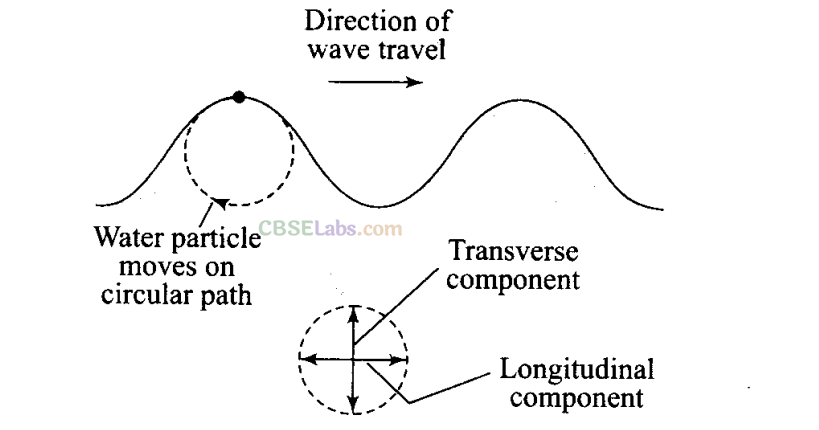
As the wave passes, water molecules at the crests move in the direction of the wave while those at the troughs move in the opposite direction.
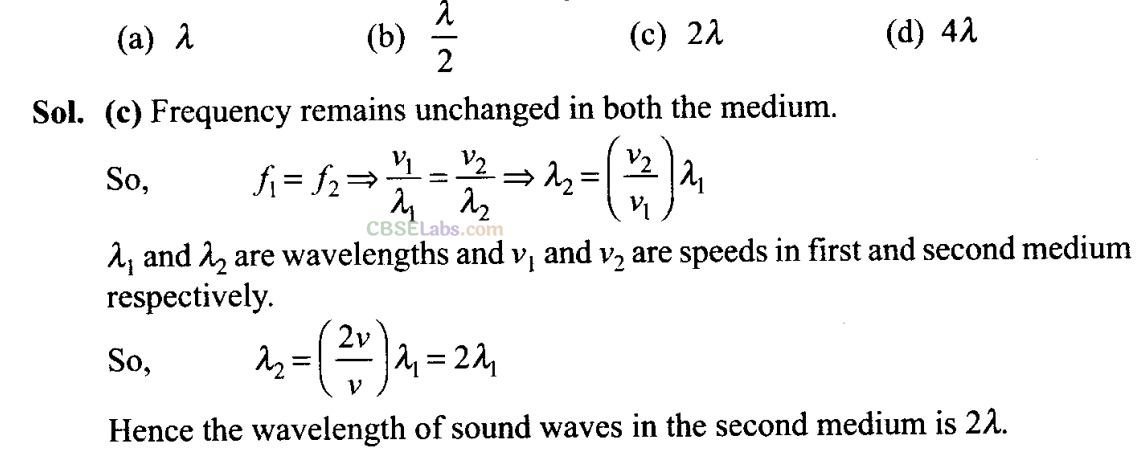
Q3. Speed of sound wave in air
(a) is independent of temperature
(b) increases with pressure
(c) increases with increase in humidity
(d) decreases with increase in humidity
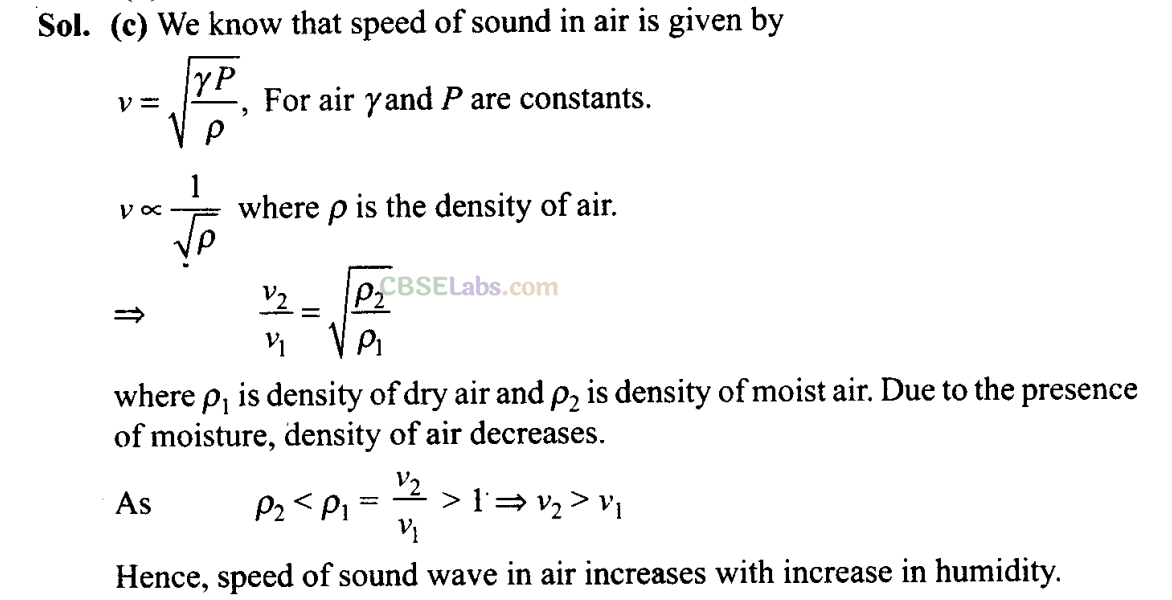
Q4. Change in temperature of the medium changes
(a) frequency of sound waves
(b) amplitude of sound waves
(c) wavelength of sound waves
(d) loudness of sound waves

Q5. With propagation of longitudinal waves through a medium, the quantity transmitted is •
(a) matter
(b) energy
(c) energy and matter
(d) energy, matter and momentum
Sol:
(b) A wave is a disturbance which propagates energy and momentum from one place to the other without the transport of matter. In propagation of longitudinal waves through a medium leads to transmission of energy through the medium without matter being transmitted. There is no movement of matter (mass) and hence momentum.
Important point:
Characteristics of wave motion: ;
• It is a sort of disturbance which travels through a medium. ,
• Material medium is essential for the propagation of mechanical waves. .
• When a wave motion passes through a medium, particles of the medium only vibrate simple harmonically about their mean position. They do leave their position and move with the disturbance.
• There is a continuous phase difference amongst successive particles of the medium, i.e. particle 2 starts vibrating slightly later than particle 1 and so on.
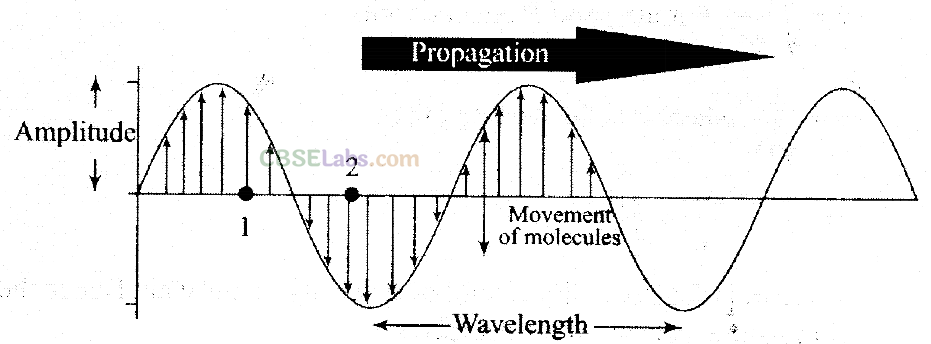
•The velocity of the particle during there vibration is differnet at different positions different positions.
• The velocity of wave motion througha particular medium is constant.
It depends only on die nature of medium not op the frequency, wavelength or intensity,
•Energy is, propagated along with thewave motion without any net transport of themedium.
Q6. Which of the following statements are true for wave motion?
(a) Mechanical transverse waves can propagate through all mediums.
(b) Longitudinal waves can propagate through solids only.
(c) Mechanical transverse waves can propagate through solids only.
(d) Longitudinal waves can propagate through
vacuum
.
Sol:
(c) In case of mechanical transverse wave propagates through a medium, the medium particles oscillate right angles to the direction of wave motion or energy propagation. It travels in the form of crests and troughs.
When mechanical transverse wave propagates through a medium element of the medium is subjected to shearing stress. Solids and strings have shear modulus, that is why, sustain shearing stress. Fluids have no shape of their own, they yield to shearing stress. Transverse waves can be transmitted through solids, they can be setup on the surface of liquids. But they cannot be transmitted into liquids and gases.
Q7. A sound wave is passing through air column in the form of compression and rarefaction. In consecutive compressions and rarefactions,
(a) density remains constant
(b) Boyle’s law is obeyed
(c) bulk modulus of air oscillates
(d) there is no transfer of heat
Sol:
(d)
Key concept:
• When sound wave travels through a medium, say air, the particles of medium disturb in the same fashion, i.e. compression and rarefaction (depression). When air particles come closer it is called compression. On the other hand, when particles go farther than their normal position it is called rarefaction. In the condition of compression, molecules of medium come closer to each other and in the condition of rarefaction, molecules of the medium go farther from each other; compared to their normal positions.
• When compression takes place in the medium, the density and pressure of the medium increase. When rarefaction takes place in the medium, density and pressure of the medium decrease. This increase and decrease in density and pressure are temporary. Thus, compression is called the region of high density and pressure. Rarefaction is called the region of low density and pressure.
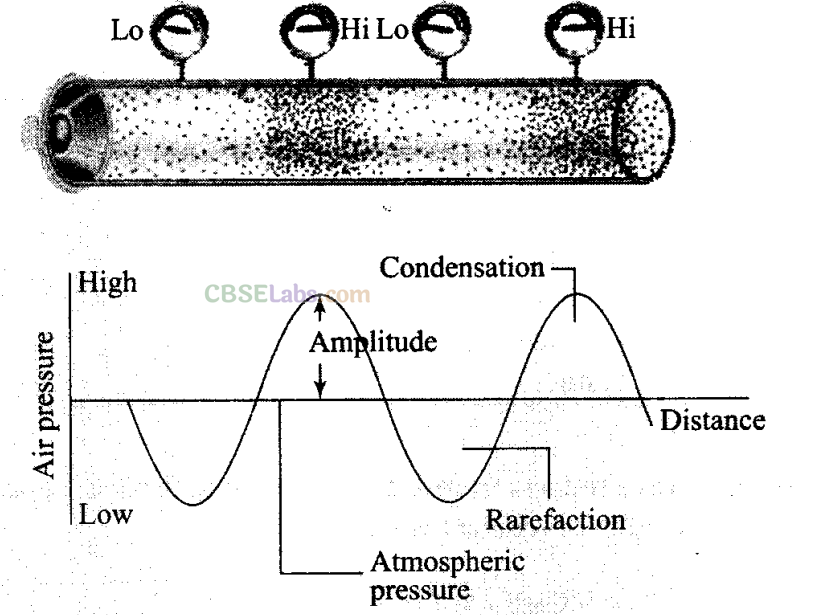
When sound wave travels through a medium:
• Due to compression and rarefaction, density of the medium (air) changes. As density is changing, so Boyle’s law is not obeyed.
• The Bulk modulus of medium remains unchanged.
• The time of compression and rarefaction is too small, i.e. we can assume adiabatic process and hence no transfer of heat.
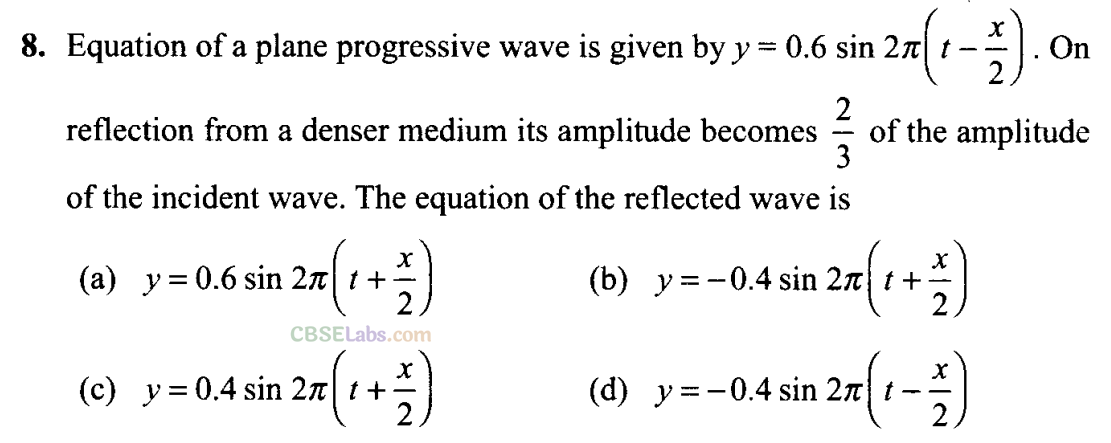
Sol:
(b)
Key concept:
Reflection of Mechanical Waves:
| Medium |
Longi
tudinal wave |
Trans
verse wave |
Change in direction |
Phase
change |
Time
change |
Path
change |
| Reflection from rigid end/ denser medium | Compression as rarefaction and vice- versa | Crest as crest and Trough as trough | Reversed |
T/2
|
λ/2 | |
| Reflection from free end/ rarer medium | Compression as compression and rarefaction as rarefaction |
Crest as
trough and Trough as crest |
No
change |
Zero | Zero | Zero |


Q9. A string of mass 2.5 kg is under tension of 200 N. The length of the stretched string is 20.0 m. If the transverse jerk is struck at one end of the string, the disturbance will reach the other end in
(a) 1 s
(b) 0.5 s
(c) 2 s
(d) data given is insufficient
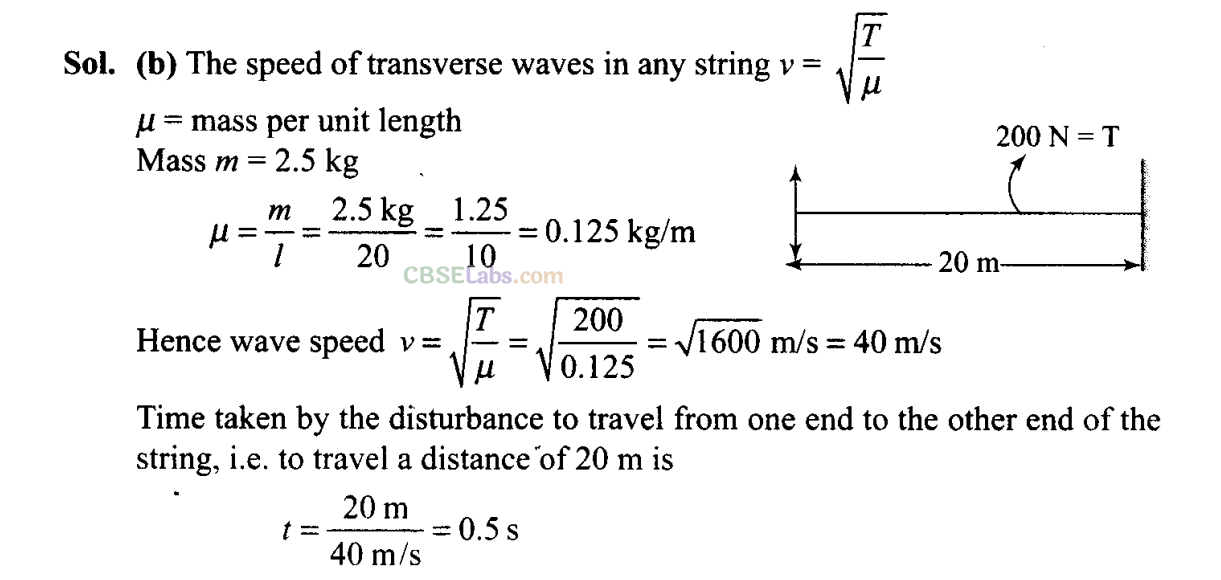
Q10. A train whistling at constant frequency is moving towards a station at a constant speed v. The train goes past a stationary observer on the station. The frequency n of the sound as heard by the observer is plotted as a function of time t (figure). Identify the expected curve.
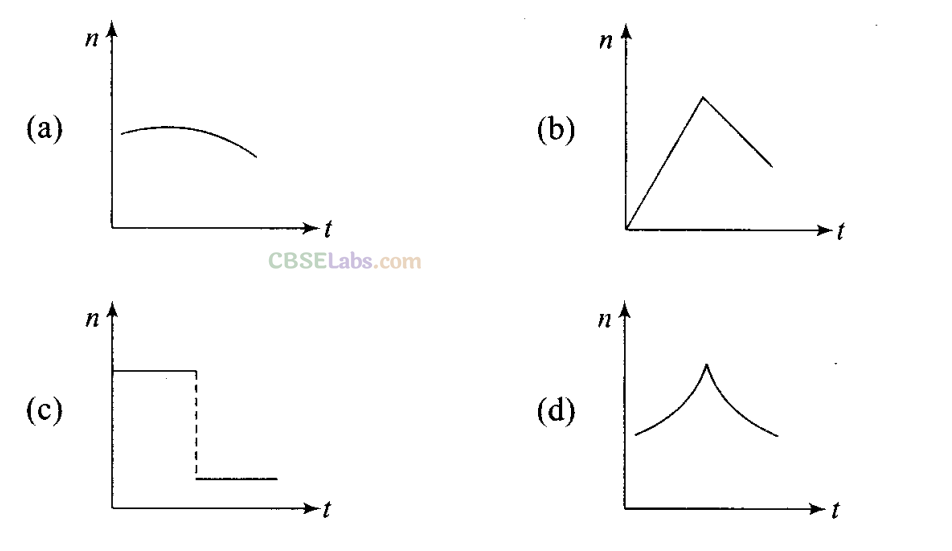
Key concept: General expression for Apparent Frequency. Suppose observer (O) and source (S) are moving in the same direction along a line with velocities v
0
and v
s
respectively. Velocity of sound is v and velocity of medium is v
m
, then apparent frequency observed by observer is given
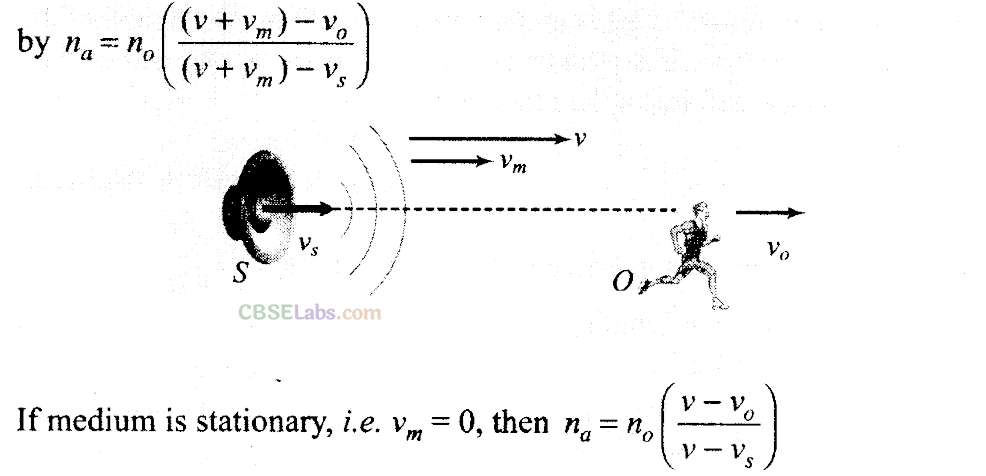
Sign convention for different situations:
- The direction of v is always taken from source to observer.
- All the velocities in the direction of v are taken positive.
- All the velocities in the opposite direction of v are taken negative.
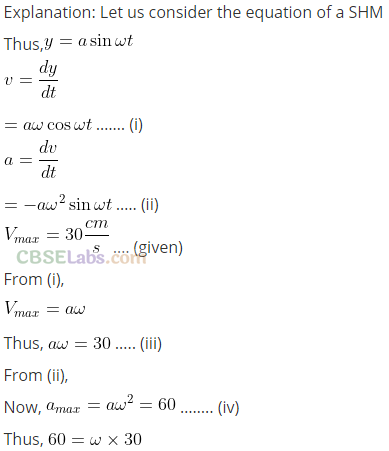
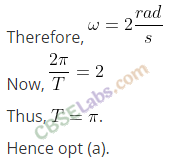
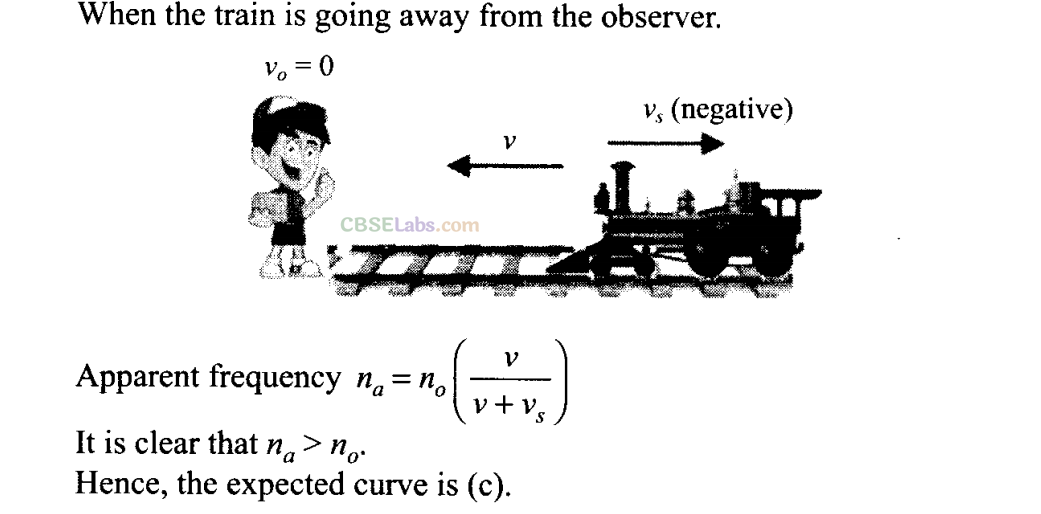
More Than One Correct Answer Type
Q11.
A transverse harmonic wave on a string is described by

where x and y are in cm and t is in sec. The positive direction of x is from left to right.
(a) the wave is travelling from right to left
(b) the speed of the wave is 20 m/s
(c) frequency of the wave is 5.7 Hz
(d) the least distance between two successive crests in the wave is 2.5 cm
Sol:
(a, b, c)
Key concept: The general equation of a plane progressive wave with initial phase is

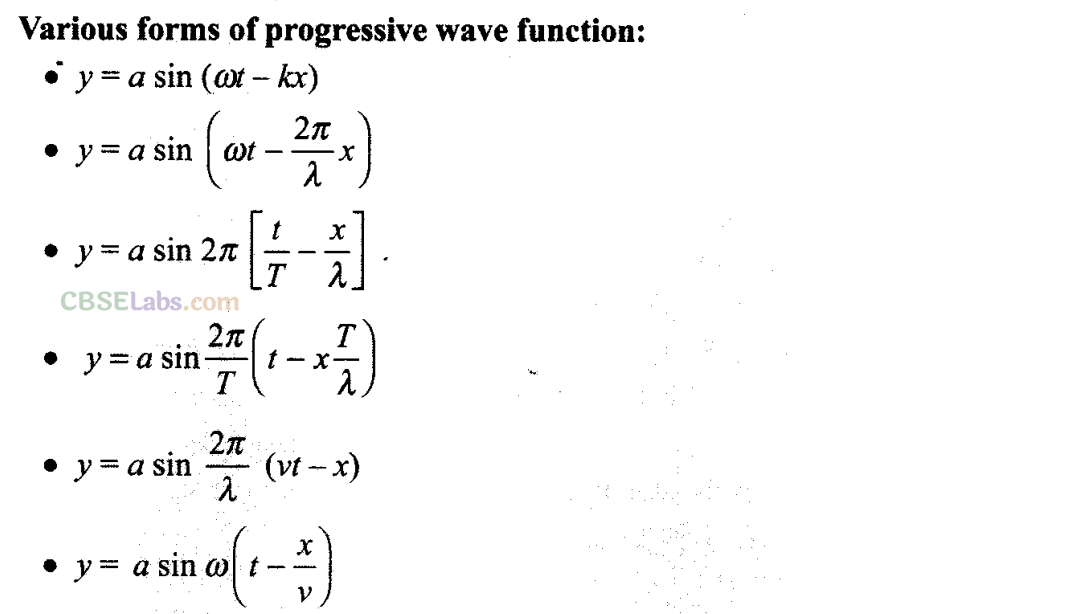
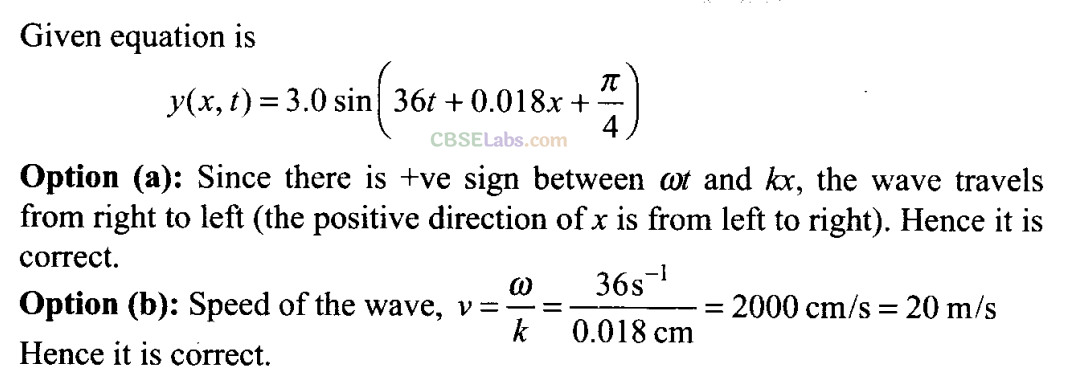


(a) It represents a progressive wave of frequency 60 Hz.
(b) It represents a stationary wave of frequency 60 Hz.
(c) It is the result of superposition of two waves of wavelength 3 m, frequency 60 Hz each travelling with a speed of 180 m/s in opposite direction.
(d) Amplitude of this wave is constant.
Sol:
(b, c)
Key concept: Standing Waves or Stationary Waves:
When two sets of progressive wave trains of same type (both longitudinal or both transverse) having the same amplitude and same time period/ frequency/wavelength travelling with same speed along the same straight line in opposite directions superimpose, a new set of waves are formed. These are called stationary waves or standing waves.

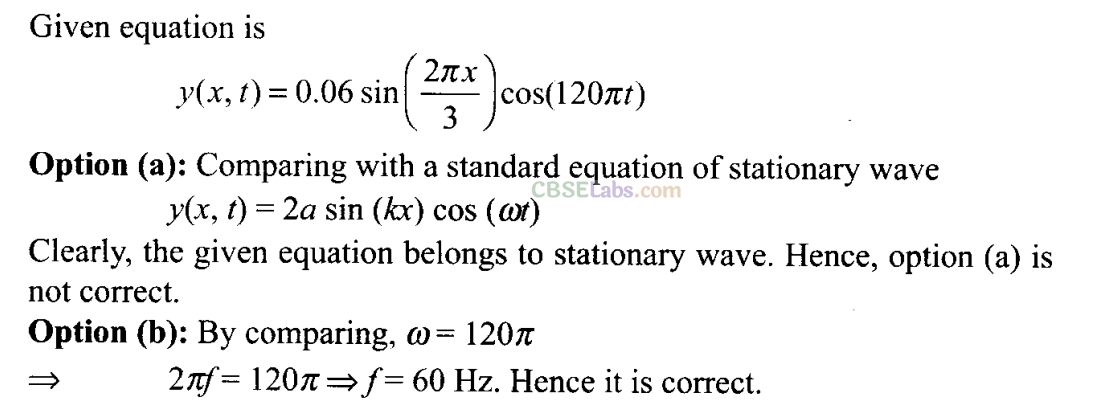

Q13. Speed of sound waves in a fluid depends upon
(a) directly on
density
of the medium
(b)
square
of
Bulk
modulus of the medium
(c) inversely on the square root of density
(d) directly on the square root of bulk modulus of the medium
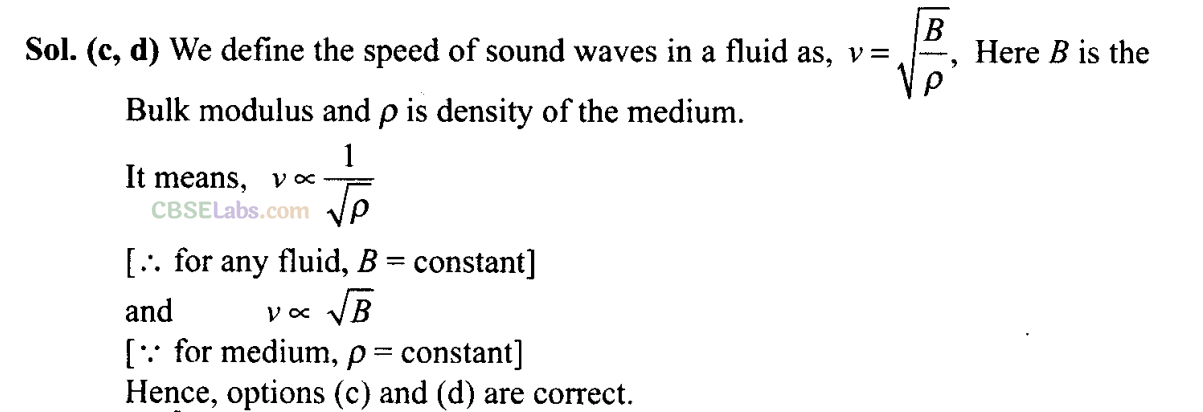
Q14. During propagation of a plane progressive mechanical wave,
(a) all the particles are vibrating in the same phase
(b) amplitude of all the particles is equal
(c) particles of the medium executes SHM
(d) wave velocity depends upon the nature of the medium
Sol:
(b, c, d)
Key concept:
Characteristics of wave motion:
• When a wave motion passes through a medium, particles of the medium only vibrate simple harmonically about their mean position. They do not move with the disturbance.
• Medium particles oscillate with same frequency and also the amplitude of oscillation of all the particles is equal. All the particles marked as 1, 2, 3,4 and 5 oscillate with the same frequency.
• There is a continuous phase difference amongst successive particles of the medium, i.e. particle 2 starts vibrating slightly later than particle 1 and so on.
• The velocity of the particle during their vibration is different at different positions.
• The velocity of wave motion through a particular medium is constant. It depends only on the nature of medium not on the frequency, wavelength or intensity.
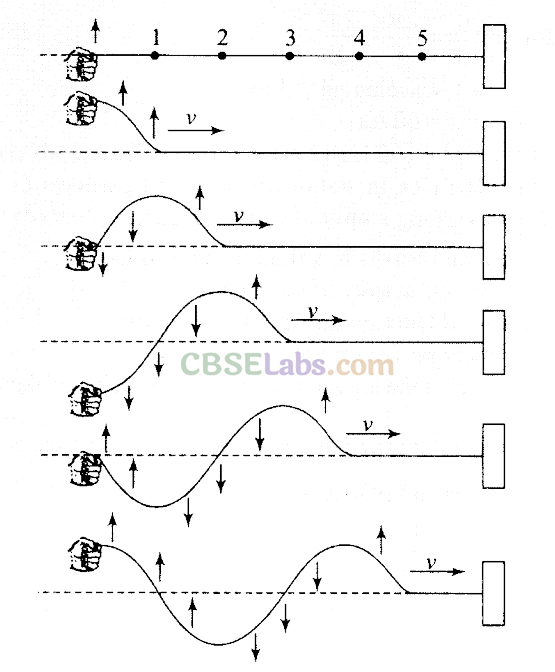
Option (a):
Clearly, the particles 1, 2 and 3 are having different phase.
Option (b) and (c):
Particles of the wave shown in the figure executes SHM with same amplitude.
Option (d):
The wave velocity of mechanical wave depends only on elastic and inertia property of medium for a progressive wave propagating in a fluid. Hence wave velocity depends upon the nature of the medium.

Q15. The transverse displacement of a string (clamped at its both ends) is given by

All the points on the string between two consecutive nodes vibrate with
(a) same frequency
(b) same phase
(c) same energy
(d) different amplitude
Sol: (a, b, d)
Key concept:
• The points for which amplitude is minimum are called nodes in a stationary wave, nodes are equally spaced at a distance λ/2.
• The points for which amplitude is maximum are called antinodes. Like nodes, antinodes are also equally spaced with spacing (λ/2) Furthermore, nodes and antinodes are alternate with spacing (λ/4).
• The nodes divide the medium into segments (or loops). All the particles in a segment vibrate in same phase, but in opposite phase with the particles in the adjacent segment. Twice in one period all the particles pass through their mean position simultaneously with maximum velocity (A at), the direction of motion being reversed after each half cycle.
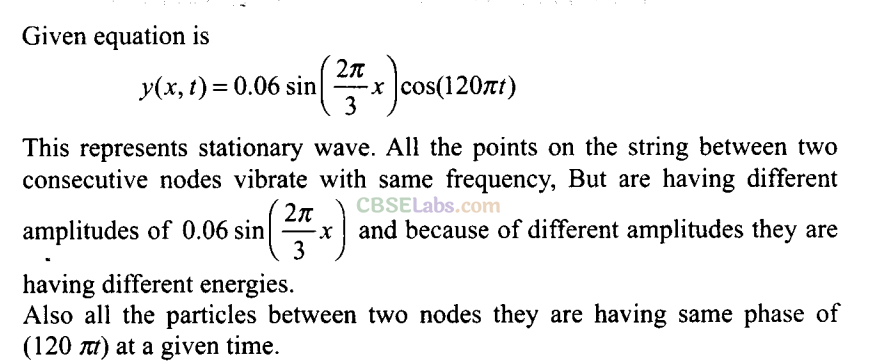
Q16. A train, standing in a station yard, blows a whistle of frequency 400 Hz in still air. The wind starts blowing in the direction from the yard to the station with a speed of 10 m/s. Given that the speed of sound in still air is 340 m/s. Then.
(a) the frequency of sound as heard by an observer standing on the platform is 400 Hz
(b) the speed of sound for the observer standing on the platform is 350 m/s
(c) the frequency of sound as heard by the observer standing on the platform will increase
(d) the frequency of sound as heard by the observer standing on the platform will decrease
Sol:
(a, b) When the wind is blowing in the same direction as that of sound wave, then net speed of the wave is sum of speed of sound wave and speed of the wind.
Given, f
0
= 400 Hz, v = 340 m/s Speed of wind v
w
= 10 m/s
Option (a): As there is no relative motion between the source and observer, hence frequency observed will be the same as natural frequency f
0
= 400 Hz
Option (b): When the wind is blowing in the same direction as that of sound wave, then net speed of the wave is sum of speed of sound wave and speed of the wind. The speed of sound v = v + v
w
= 340+ 10 = 350 m/s
Option (b) and (c): There will be no change in frequency because there is no relative motion between source and observer. Hence (c) and (d) are incorrect.
Q17. Which of the following statement are true for
a stationary waves
?
(a) Every particle has a fixed amplitude which is different from the amplitude of its nearest particle.
(b) All the particles cross their mean position at the same time.
(c) All the particles are oscillating with
same
amplitude.
(d) There is no net transfer of energy across any plane.
(e) There are some particles which are always at rest.
Sol:
(a, b, d, e) Consider the equation of a stationary wave
y(x, t) = 2a sin (kx) cos (wt)
Option (a):
In stationary wave any particle at a given position have amplitude 2a sin kx.
Option (b):
The time period of oscillation of all the particles is same, hence all the particles cross their mean position at the same time.
Option (c):
Amplitude of all the particles are 2a sin kx which is different for different particles at different values of x.
Options (d) and (e):
Nodes are the points which is always at rest hence no transfer of energy across the nodes. It means the energy is a stationary wave is confined between two nodes.
Q18. A sonometer wire is vibrating in resonance with a tuning fork. Keeping the tension applied same, the length of the wire is doubled. Under what conditions would the tuning fork still be in resonance with the wire?
Sol:
Wire of sonometer is twice the length which it vibrates in its second harmonic. Thus, if the tuning fork resonates at L, it will resonate at 2L. This can be explained as below:
The frequency of sonometer is given by
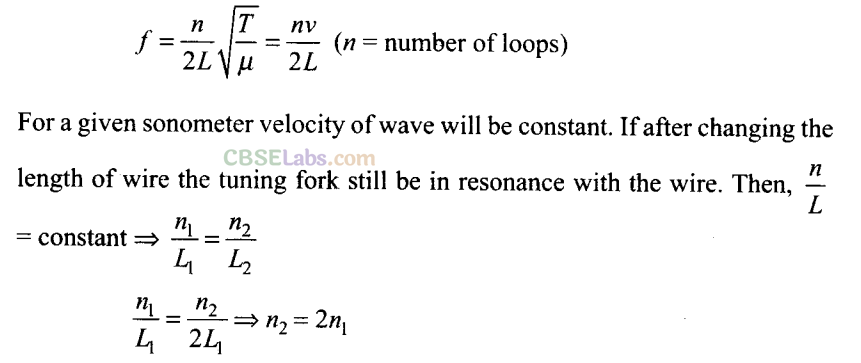
Hence, when the wire is doubled the number of loops also get doubled to produce the resonance. That is it resonates in second harmonic.
Q19. An organ pipe of length L open at both ends is found to vibrate in its first harmonic when sounded with a tuning fork of 480 Hz. What should be the length of a pipe closed at one end, so that it also vibrates in its first harmonic with the same tuning fork?
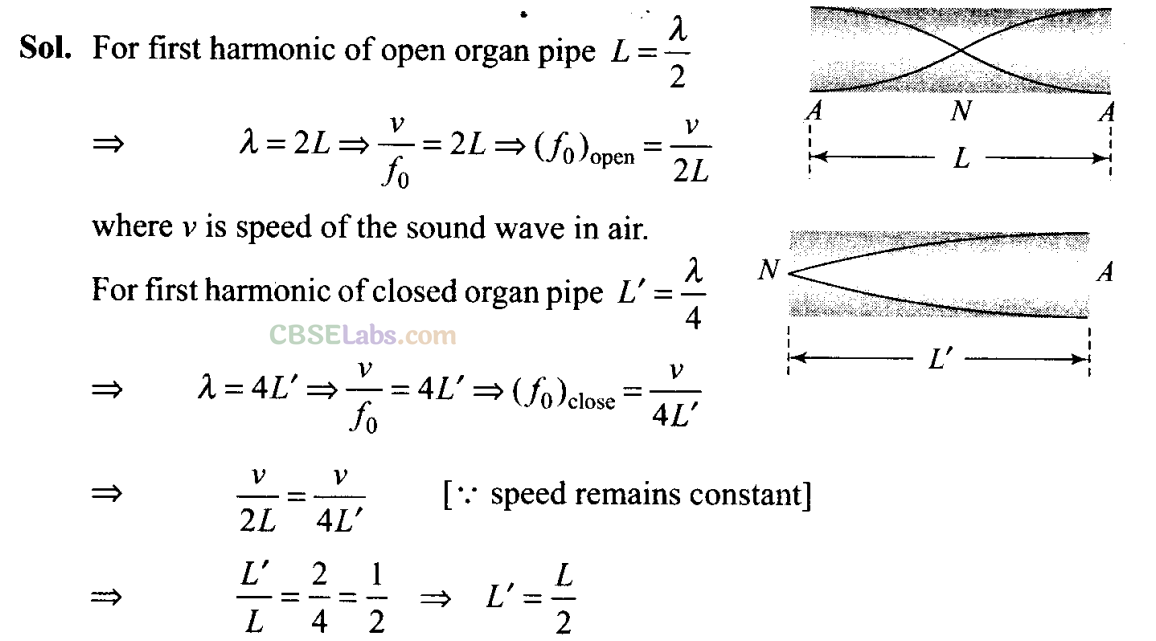
Q20. A tuning fork
A,
marked 512 Hz, produces 5 beats per second, when sounded with another unmarked tuning fork B. If B is loaded with wax the number of beats is again 5 per second. What is the frequency of the tuning fork B when not loaded?
Sol:
When the prong of B is loaded with wax, its frequency becomes less than the original frequency.
If we assume that the original frequency of B is 507, then on loading its frequency will be less than 507. The beats between A and B will be more than 5.
If we assume that the original frequency of B is 517, then on loading its frequency will be less than 517. The beats between A and B may be equal to 5. Hence the frequency of the tuning fork B when not loaded should be 517.
Q22. The displacement of an elastic wave is given by the function, y = 3 sin ωx + 4 cos ωt, where y is in cm and t is in second. Calculate the resultant amplitude.
Sol:
Given, displacement of the wave
y = 3 sin ωx + 4 cos ωx
Let us assume, 3 = A cos θ . .. .(i)
3=Acos θ …(ii)
On dividing Eq. (ii) by Eq. (i)
tan θ = 4/3 => ϕ= tan
-1
(4/3)
Squaring and adding equations (i) and (ii),
A
2
cos
2
θ + A
2
sin
2
θ = 3
2
+ 4
2
=> A
2
(cos
2
θ + sin
2
θ) = 25
A
2
= 25 => A = 5. Hence, amplitude = 5 cm
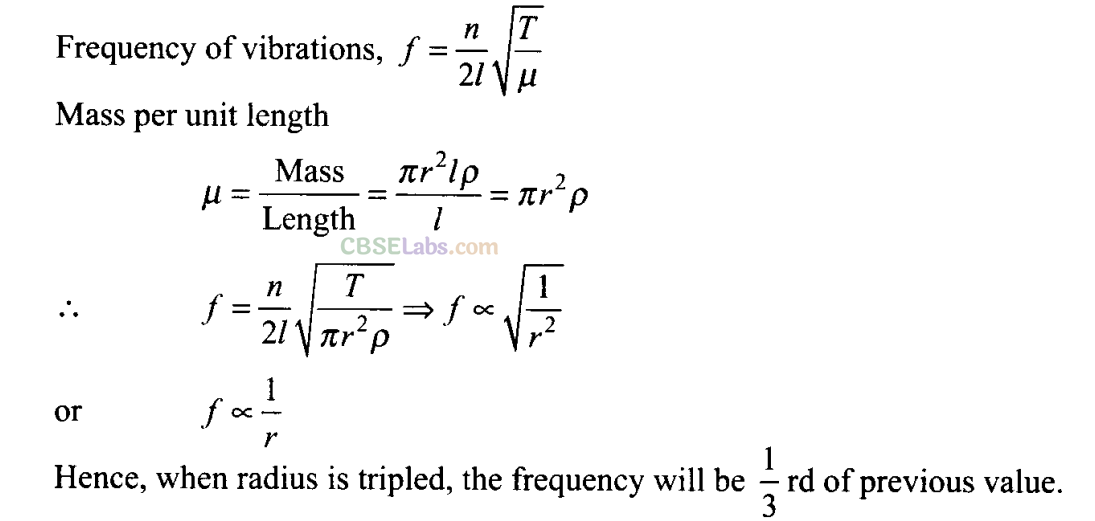
Q23.
At what temperatures (in °C) will the speed of sound in air be 3 times its value at 0°C?
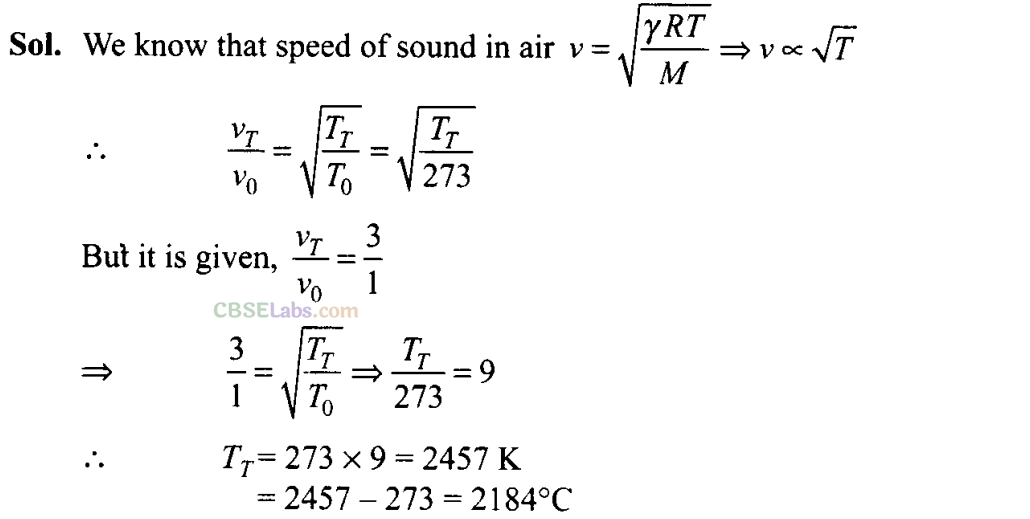
Q24.
When two waves of almost equal frequencies n
l
and n
2
reach at a point simultaneously, what is the time interval between successive maxima?

Short Answer Type Questions
Q25. A steel wire has a length of 12 m and a mass of 2.10 kg. What will be the speed of a transverse wave on this wire when a tension of 2.06 x 10
4
N is applied?
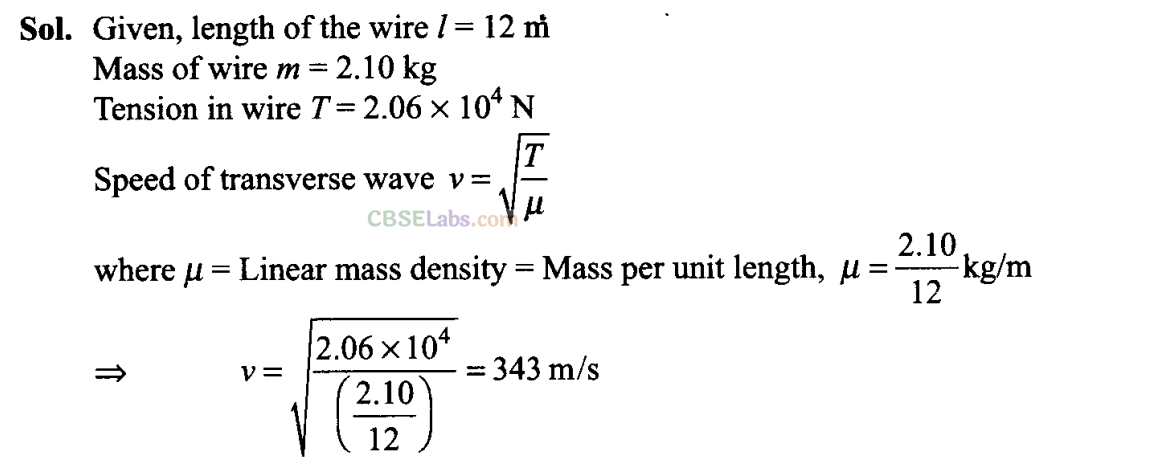
Q26. A pipe 20 cm long is closed at one end. Which harmonic mode of the pipe
is
resonantly excited by a source of 1237.5 Hz? (Sound velocity in air = 330 ms
-1
)
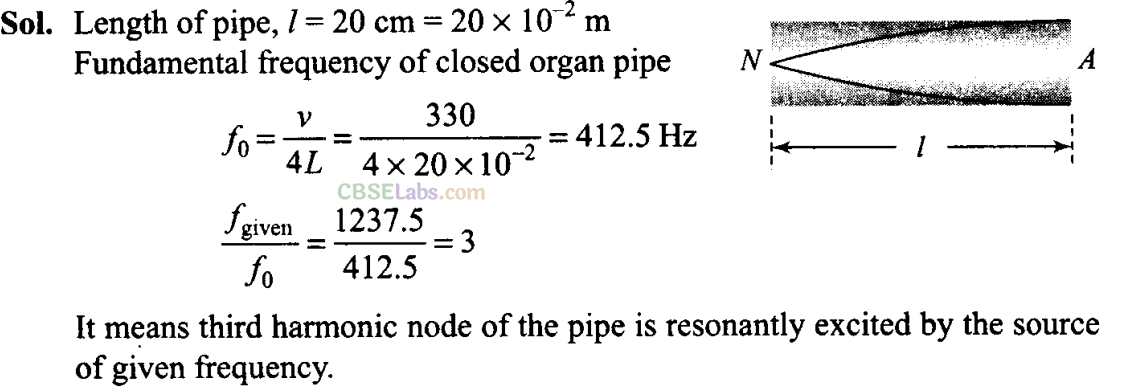
Q27. A train standing at the outer signal of a railway station blows a whistle of frequency 400 Hz in still air. The train begins to
move with a speed of 10 ms’
1
towards the platform. What is the frequency of the sound for an observer standing on the
platform? (Sound velocity in air = 330 ms
-1
)
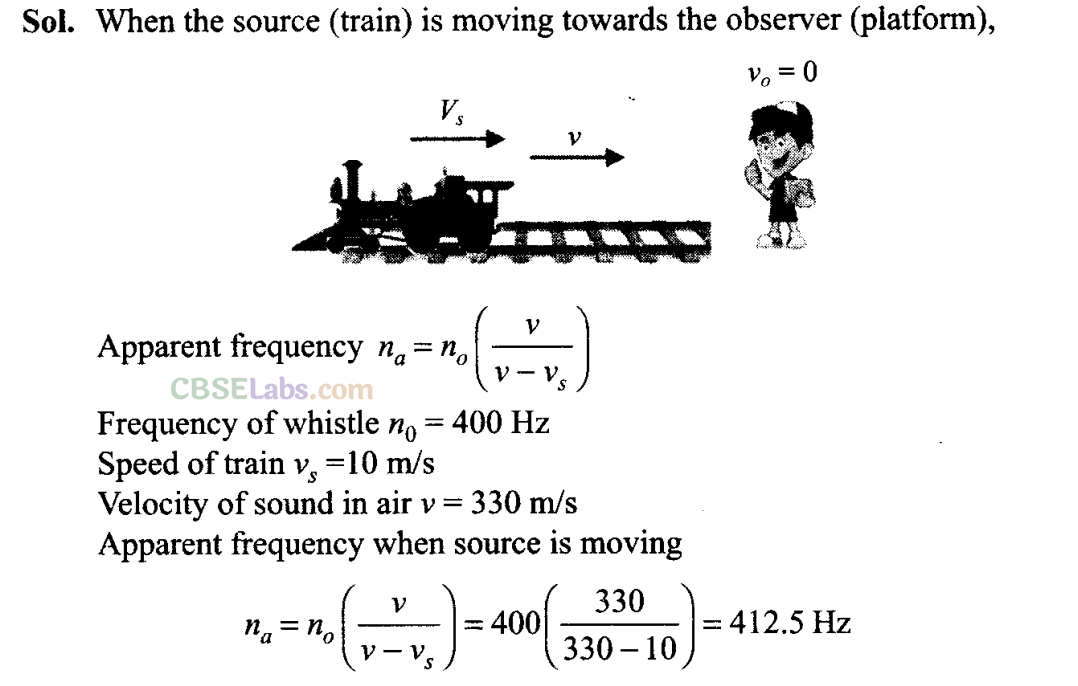
Q28. The wave pattern on a stretched string is shown in figure. Interpret what kind of wave this is and find its
wavelength.
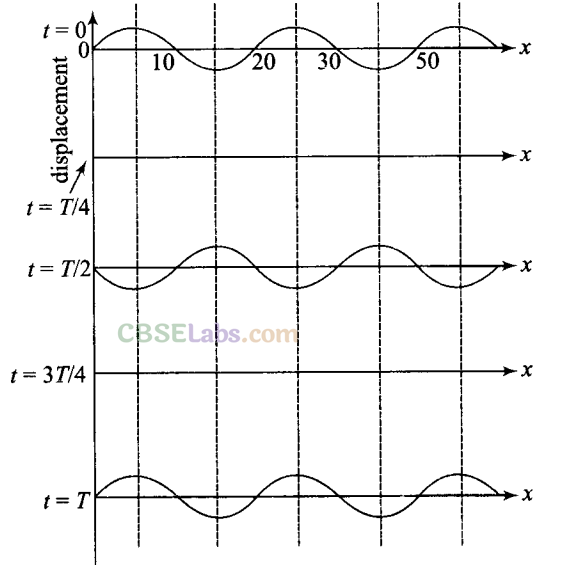
Sol. If we observe the graph there are some points on the graph which are always at rest. The points on positions x = 10,20,30,40 never move, always at mean position with respect to time. These are forming nodes which characterize a stationary wave.
We know the distance between two successive nodes is equal to λ/2
=> λ = 2 x (node to node distance)
= 2 x (20 – 10) = 20 cm
Q29. The pattern of standing waves formed on a stretched string at two instants of time
are
shown in
figure
. The velocity of two waves superimposing to form stationary waves is 360 ms
-1
and their frequencies are 256 Hz.
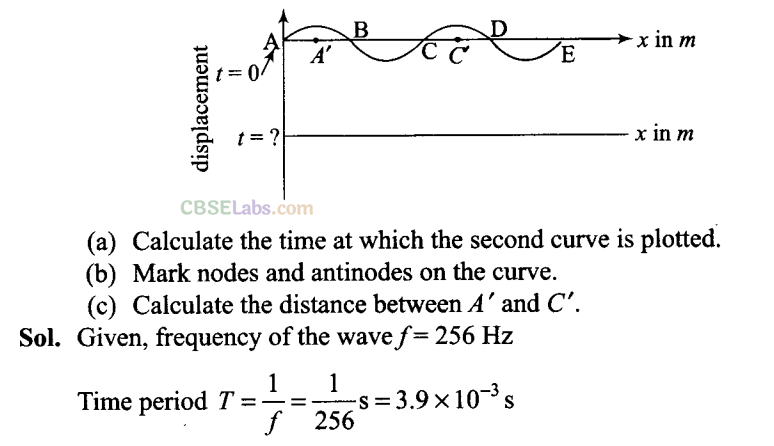
(a) In second plot, the displacement of each particle is zero. It means all the points are crossing mean position. At first plot point at A
1
is at amplitude position. Time taken to move from amplitude position to mean position to is equal to one-fourth of the time period.
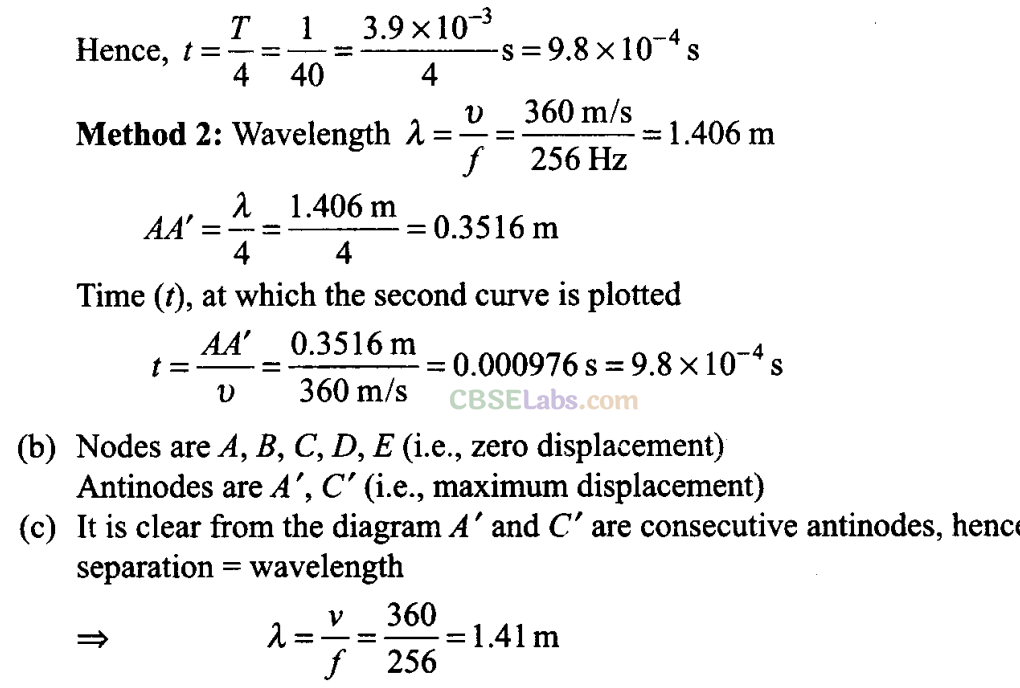
Q30. A tuning fork vibrating
with
a frequency of 512 Hz is kept close to the open end of a tube filled with water (figure). The water level in the tube is gradually lowered. When the water level is 17 cm below the open end,
maximum
intensity of sound is heard.
If the room temperature is 20°C, calculate
(a) speed of sound in air at room temperature.
(b)
speed
of sound in air at 0°C.
(c) if the water in the tube is replaced with mercury, will there be any difference in your observations?
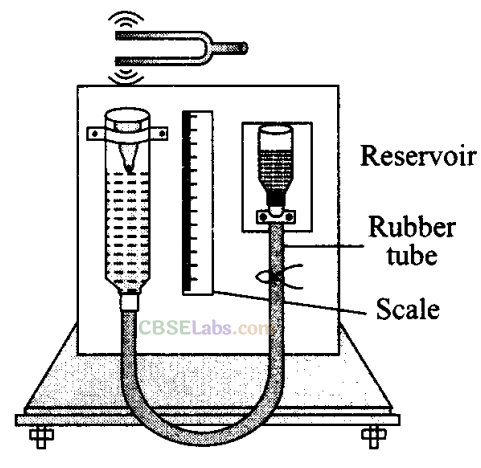
Sol:
If a pipe partially filled with water whose upper surface of the water acts as a reflecting surface of a closed organ pipe. If the length of the air column is varied until its natural frequency equals the frequency of the fork, then the column resonates and emits a loud note.
The frequency of tuning fork,f= 512 Hz.
For observation of first maxima of intensity,

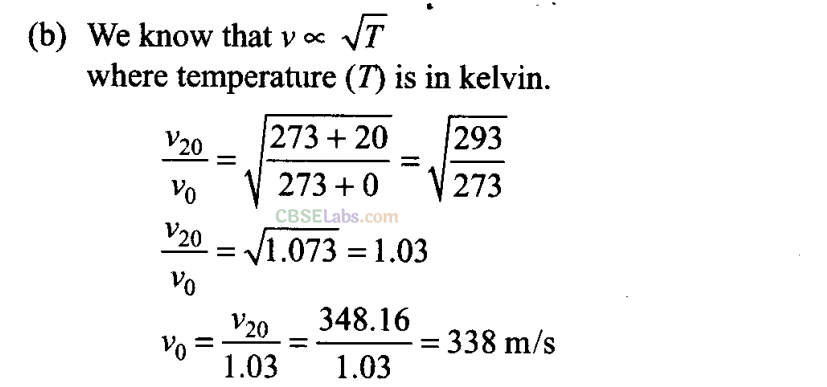
(c) The resonance will still be observed for 17 cm length of air column above mercury. However, due to more complete
reflection of sound waves at mercury surface, the intensity of reflected sound increases.
Q31. Show that when a string fixed at its two ends vibrates in 1 loop, 2 loops, 3 loops and 4 loops, the frequencies are in the ratio 1 : 2 : 3 : 4.
Sol: Key concept: For a string fixed at its two ends vibrate in a normal mode if it vibrates according to the equation
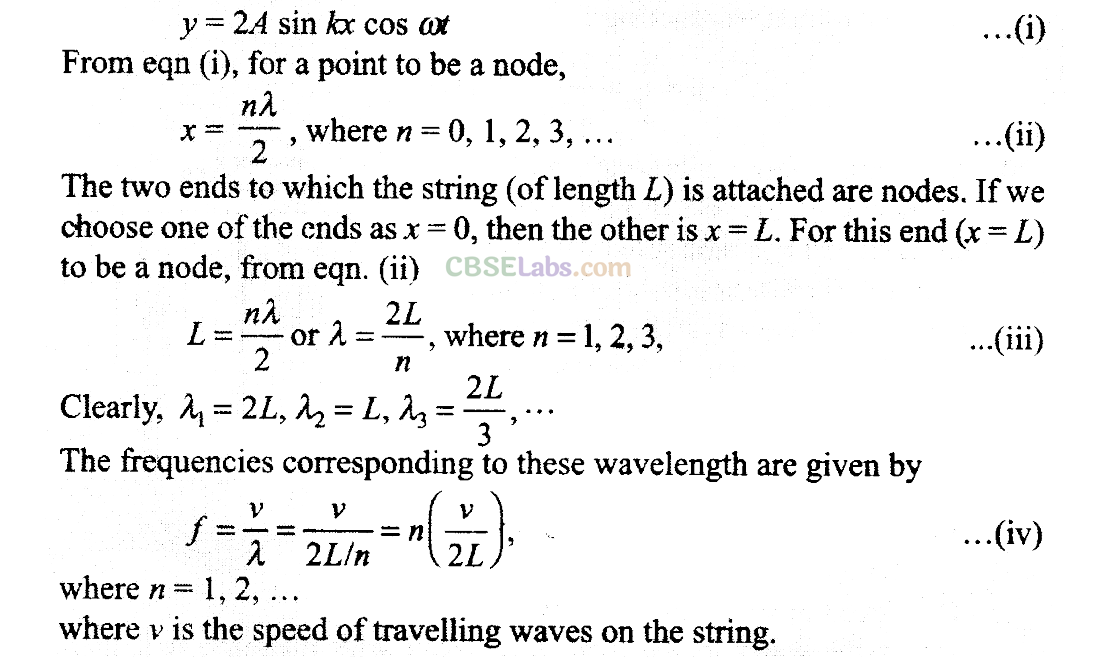
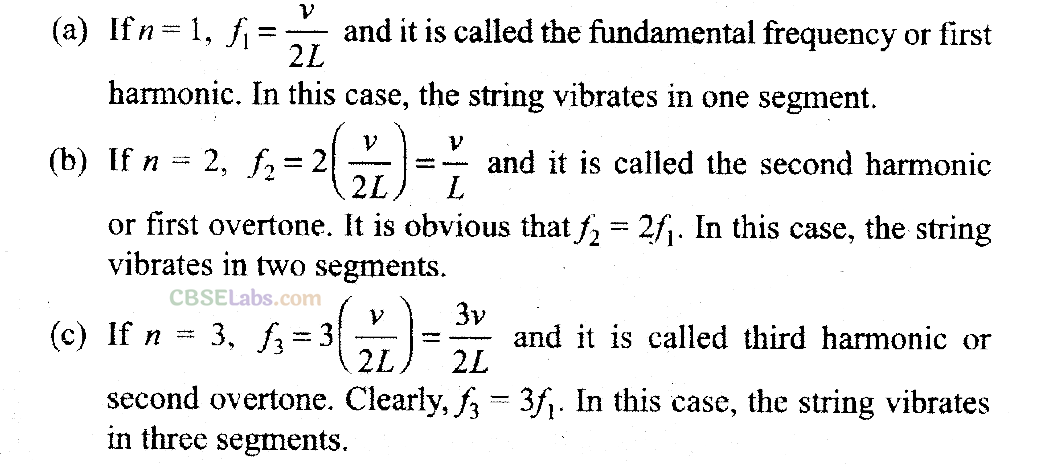
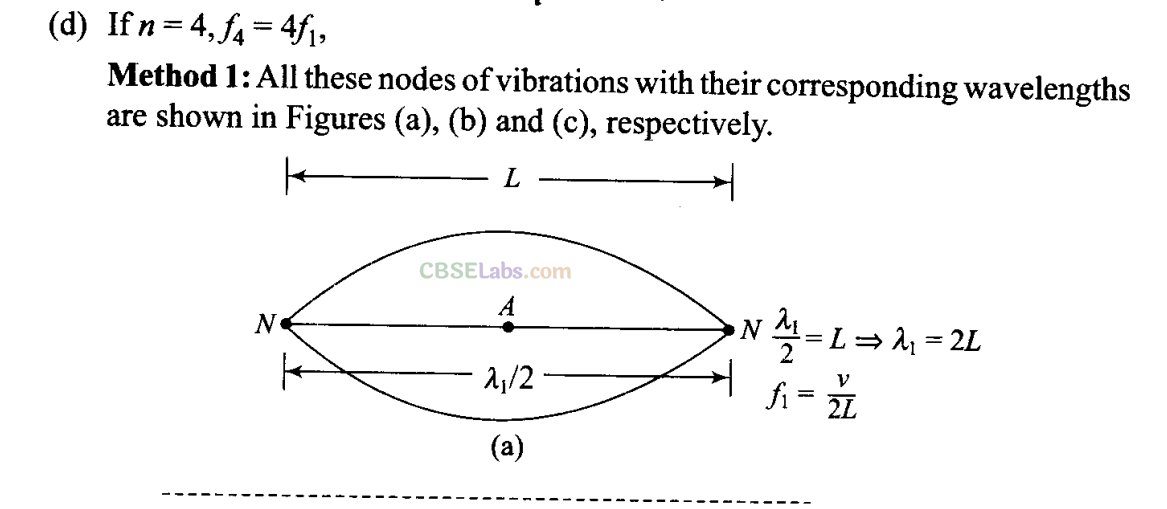
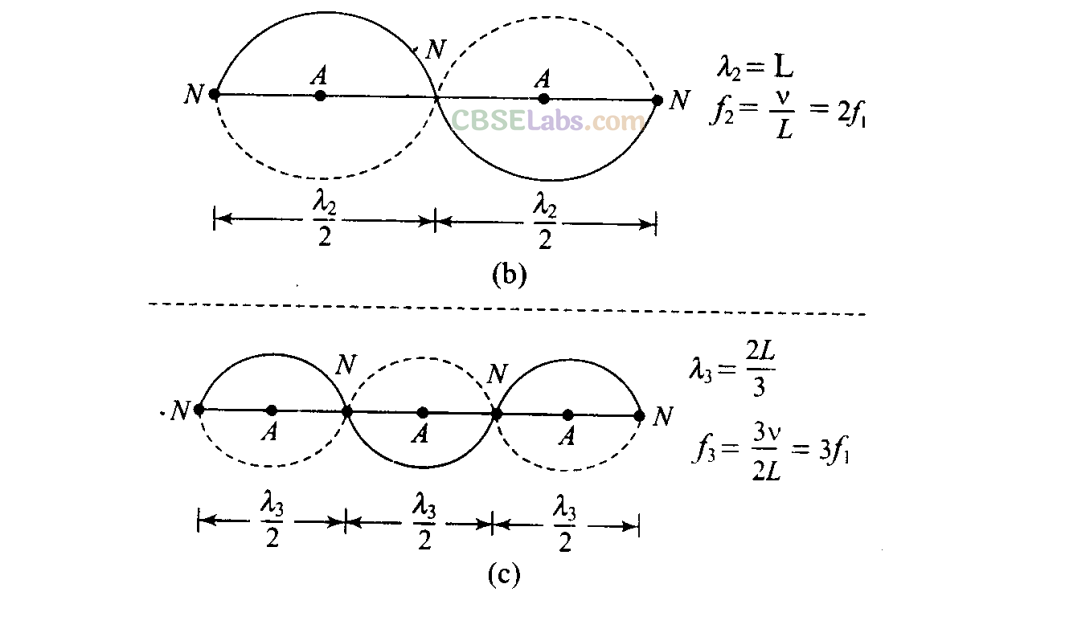
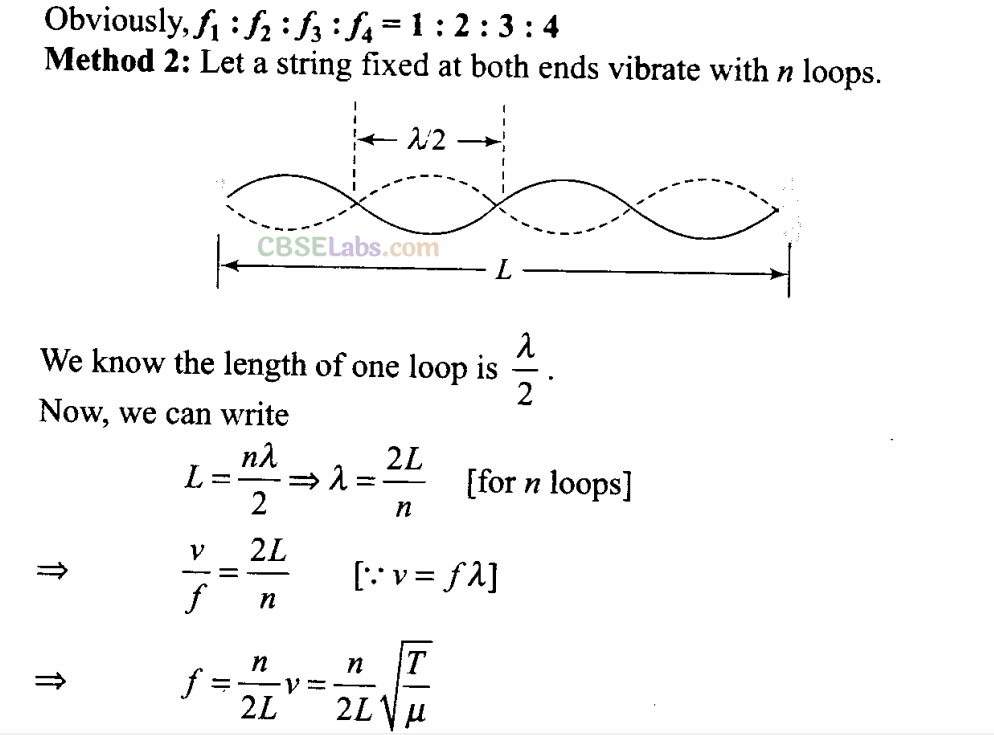

NCERT Exemplar Class 11 Physics Solutions
- Chapter 1 Units and Measurements
- Chapter 2 Motion in a Straight Line
- Chapter 3 Motion in a Plane
- Chapter 4 Laws of Motion
- Chapter 5 Work, Energy and Power
- Chapter 6 System of Particles and Rotational Motion
- Chapter 7 Gravitation
- Chapter 8 Mechanical Properties of Solids
- Chapter 9 Mechanical Properties of Fluids
- Chapter 10 Thermal Properties of Matter
- Chapter 11 Thermodynamics
- Chapter 12 Kinetic Theory
- Chapter 13 Oscillations
- Chapter 14 Waves